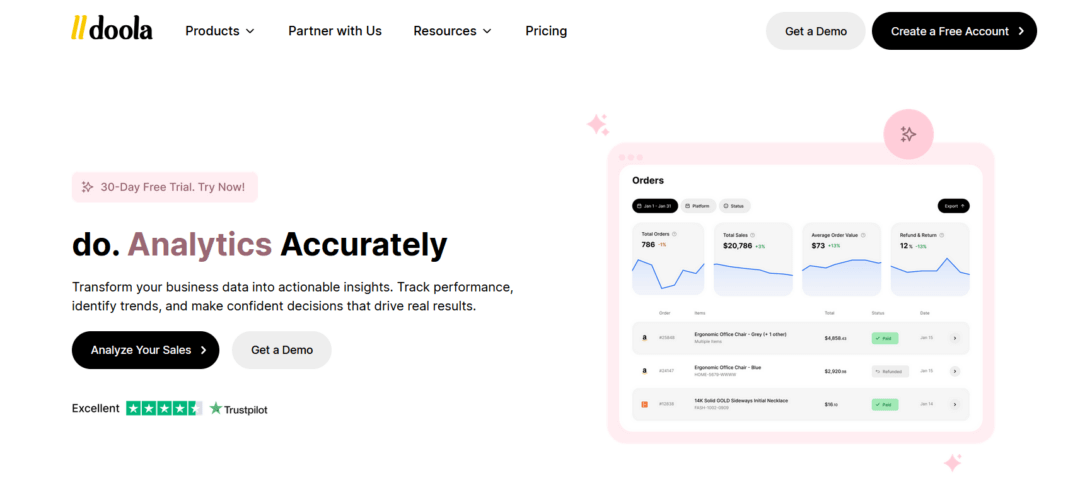Language:
What Is E-Commerce Business Analytics? A Beginner-Friendly Guide for Store Owners

90% of e-commerce businesses fail within the first 120 days, often because they’ve no clear view of what’s working.
You can’t improve what you can’t measure. That’s where e-commerce business analytics comes in.
Imagine making every business decision with clarity and confidence, with no more trial and error, only insight-led action.
From tracking sales trends to identifying your most profitable products, analytics isn’t just another dashboard. It’s your unfair advantage in an ultra-competitive space.
In this guide, we’ll break down what e-commerce business analytics actually means (without the jargon), why it’s critical for store owners, and how you can use it to grow smarter, not harder.
We’ll also show you how tools like doola Analytics simplify the process, so you can stop guessing and start scaling.
What Is E-Commerce Business Analytics?
At its core, e-commerce business analytics is the practice of collecting, analyzing, and using data from your online store to make better decisions. It combines the power of business insights with the speed and complexity of e-commerce platforms like Shopify and Amazon.
Instead of just knowing your sales total at the end of the month, analytics helps you understand why your sales went up or down.
Which products are performing best? Where are customers dropping off? Which ads are bringing in actual paying customers?
Here’s what it typically includes:
- Customer behavior tracking: What people are clicking, buying, or abandoning in your store.
- Revenue patterns: Where your money comes from, and where it’s leaking.
- Marketing attribution: Which campaigns and channels are actually driving conversions.
- Inventory and product performance: What’s selling fast, what’s not moving, and why.
- Operational efficiency: How well you’re managing orders, returns, and logistics.
When done right, e-commerce analytics becomes your business co-pilot, always watching, always guiding.
Why Is Business Analytics Important for Online Store Owners?
Many e-commerce entrepreneurs pour time and money into ads, inventory, and marketing efforts without ever really knowing what’s working and what’s quietly draining their resources.
Take digital advertising, for example. You might be running Google or Facebook ads with a decent click-through rate, but you won’t know which campaigns are actually converting browsers into buyers.
Are people abandoning their carts at checkout because of unexpected shipping fees? Are your email campaigns pulling in repeat buyers, or just first-time visitors who never return?
These are questions analytics can answer in seconds; answers that would otherwise take weeks of trial and error to uncover.
The right analytics tool removes the guesswork by giving you visibility into your store’s performance. You can identify bottlenecks, fine-tune your marketing, and build a customer journey that actually converts.
For instance, one Shopify store owner tracked their conversion rates and found out that they peaked between 8 PM and 10 PM. They shifted their email campaigns to match this traffic window and doubled their conversion rate within two weeks. It wasn’t luck, but was data-backed decision-making.
Business analytics gives you something every online store owner needs: clarity.
With it, you can stop making decisions based on gut instinct and start steering your business with confidence, using real-time insights to build a successful strategy.
🔖 Related Read: The Complete Glossary of E-Commerce Analytics Metrics (And What They Actually Mean)
Key Metrics and Insights in E-Commerce Business Analytics
E-commerce business analytics isn’t about obsessing over dozens of dashboards. It’s about honing in on the few key metrics that help you make better decisions.
If you could only track five things to drive smarter decisions, we have identified the most crucial key metrics for you.
These would help you understand where to spend your money, how to retain customers, and what levers actually grow your store.
| Metric | How It’s Calculated | What It Means for Decision-Making |
| Conversion Rate | (Purchases ÷ Visitors) × 100 | Optimizes site experience and product-market fit |
| Customer Lifetime Value | AOV × Purchase Frequency × Customer Lifespan | Informs how much to spend on acquisition and retention |
| Cart Abandonment Rate | [(Initiated Checkouts – Completed) ÷ Initiated] × 100 | Reveals checkout friction and recovery opportunities |
| Traffic Sources + ROI | Revenue from Channel ÷ Cost | Helps allocate marketing spend to high-performing channels |
| Repeat Purchase Rate | (Returning Customers ÷ Total Customers) × 100 | Measures loyalty and guides retention strategy |
| Average Order Value | Total Revenue ÷ Number of Orders | Helps boost revenue per transaction and improve ad economics |
Conversion Rate
The conversion rate tells you the percentage of visitors who complete a purchase. This helps you measure the effectiveness of your website, product, pricing, and user experience.
It’s calculated as:
Conversion Rate = (Total Purchases ÷ Total Visitors) × 100
For example, if 2,000 people visit your site in a week and 40 of them make a purchase, your conversion rate is 2%.
If traffic is high but conversions are low, you likely have friction points, such as slow page load times, confusing checkout steps, or a lack of trust-building elements.
Focus on identifying these bottlenecks and other issues to improve this metric and ensure fastest and most affordable gains in revenue.
📌 doola’s Pro tip for the Do’ers: The standard conversion rate for e-commerce websites averages between 2% to 5%.
Customer Lifetime Value (CLTV)
Customer Lifetime Value (CLTV) estimates how much revenue a customer will bring in over the entire time they shop with you.
It’s calculated as:
CLTV = Average Order Value × Purchase Frequency × Customer Lifespan
Let’s say your average customer spends $50 per order, orders 4 times a year, and stays loyal for 3 years. That puts your CLTV at $600.
If you know your average customer will generate $600 in revenue over their lifetime, you can comfortably spend $100 or even $150 to acquire them, especially if your margins are healthy.
It also helps you determine how much you can afford to spend to acquire a customer. CLTV also helps justify loyalty programs, retention campaigns, and improving customer service.
Cart Abandonment Rate
The cart abandonment rate measures how many customers start the checkout process but leave before completing their purchase.
It’s calculated as:
Cart Abandonment Rate = [(Initiated Checkouts – Completed Purchases) ÷ Initiated Checkouts] × 100
If 1,000 customers add products to their cart and only 700 complete their orders, your cart abandonment rate is 30%.
A high cart abandonment rate signals friction in the final step of the buying journey. This might be due to unexpected shipping fees, limited payment options, or a slow checkout page.
Reducing abandonment by even a few percentage points can yield a significant revenue boost without requiring more traffic or higher marketing spending.
📌 doola’s Pro tip for the Do’ers: The average cart abandonment rate worldwide is around 70%. This means that 70 out of every 100 online shoppers leave without completing the purchase.
Traffic Sources and ROI
Traffic sources track where your visitors are coming from, such as organic search, paid ads, social media, email campaigns, direct visits, and more.
Some channels may drive high volumes of visitors who don’t buy, while others deliver fewer visitors but with better conversion and higher AOV.
When paired with ROI (Return on Investment) data, this gives a full picture of each marketing channel’s effectiveness.
It’s calculated as:
Basic ROI = (Revenue from Campaign – Cost of Campaign) ÷ Cost of Campaign
By tracking ROI per channel, you can stop guessing and start reallocating your marketing budget to what actually works, scaling winning campaigns and eliminating wasteful spending.
📌 doola’s Pro tip for the Do’ers: The average ROI for an average e-commerce store is 18.1%, while for luxury stores it’s 50%, and for holiday e-commerce stores it’s 30%.
Repeat Purchase Rate
The repeat purchase rate shows the percentage of customers who return to make another purchase. This rate reflects customer loyalty and the long-term health of your brand.
It’s calculated as:
Repeat Purchase Rate = (Number of Returning Customers ÷ Total Number of Customers) × 100
If you had 1,200 customers in a quarter and 300 of them came back to order again, your repeat purchase rate is 25%.
High repeat purchase rates indicate strong product-market fit and customer satisfaction. It also means you’re getting more value from each buyer over time, which is crucial for improving CLTV and planning customer retention strategies.
📌 doola’s Pro tip for the Do’ers: According to e-commerce research by Metrilo, online retailers have an average repeat customer rate of 28.2%.
Average Order Value (AOV)
Average Order Value (AOV) tells you how much customers typically spend per order, which can help you grow revenue without adding more traffic or conversions.
It’s calculated as:
AOV = Total Revenue ÷ Number of Orders
If you generated $25,000 in sales from 500 orders last month, your AOV is $50.
A higher AOV improves the economics of paid marketing, making each customer acquisition dollar stretch further.
If you can nudge customers to add one more item to their cart or hit a free shipping threshold, you instantly make each transaction more profitable.
📌 doola’s Pro tip for the Do’ers: The standard AOV in e-commerce is estimated to be around $116. However, luxury and jewelry have the highest AOV at around $436, while beauty and personal care have the lowest at about $71.
How to Use Analytics to Optimize Your E-Commerce Business

Knowing your numbers is just the first step. The real power of analytics comes from using those insights to improve performance, increase revenue, and build a healthier business.
Let’s explore how data can be applied to real-world scenarios and how analytics make that process faster and easier.
Step 1: Identify the Bottleneck
Start by asking: Where is the drop-off happening? Are visitors abandoning their carts? Are they not converting at all? Is your average order value (AOV) too low?
If 70% of customers leave after adding items to their cart, your checkout process may be too long, confusing, or not mobile-friendly.
What to try:
- Simplify the checkout flow by using analytics to see the exact step where users exit, e.g., shipping page or payment screen.
- Add guest checkout if data shows new users have a higher drop-off rate than returning ones.
- Ensure mobile responsiveness if mobile sessions convert lower than desktop ones (e.g., 1% vs. 3%).
Step 2: Diagnose the Cause
Now that you’ve spotted the issue, it’s time to dig deeper. Use behavioral insights to understand why it’s happening.
If customers only buy one item per order, they may not see value in adding more.
What to try:
- Offer product bundles based on purchase data that shows what items are often bought together.
- Introduce tiered discounts by analyzing order distribution (e.g., many orders are just below $50, create an incentive to cross that threshold).
- Upsell during checkout using past transaction data to suggest relevant add-ons.
Step 3: Test a Fix
Data should guide experimentation, not just observation. This is where A/B testing and customer behavior tools come in.
If you’re getting the traffic but not the sales, your product pages may not be converting.
What to try:
- Run an A/B test on product page layouts, based on heatmap data showing low engagement with CTAs.
- Add customer reviews if analytics show a high bounce rate on product pages without social proof.
- Improve product copy if session replay data shows users scrolling fast or exiting quickly.
Step 4: Track Impact and Iterate
You’ve made a change. Now, measure its impact. Did conversions go up? Are people spending more per order?
If customers buy once and never return, you may be missing post-purchase engagement or personalization.
What to try:
- Send restock reminders if analytics show customers reorder similar products every 30–60 days.
- Launch a loyalty program if CLTV data shows high-spending customers are under-engaged after their first few purchases.
- Segment repeat buyers using RFM (recency, frequency, monetary) analysis to personalize offers.
Step 5: Use the Right Tools to Go Deeper
Once you’ve spotted an issue and brainstormed ideas, the next step is choosing the right tools to bring those ideas to life, fast. That’s where doola helps!
Instead of juggling multiple dashboards and tools, doola Analytics pulls your customer behavior, sales performance, and past trends into one intuitive platform to guide action.
It gives you:
- Clear funnels to identify drop-offs
- Smart suggestions on what to test
- Actionable insights on product, pricing, and user experience
- Easy integrations with your marketing stack for smoother execution
It’s the tool you must have in your arsenal to move from “we think” to “we know” and act with confidence.
We’ve brought you a list:
| Tool | What It Does | Use Case |
| Heatmaps (e.g. Hotjar, Crazy Egg) | Visualize where users click, scroll, or drop off | Spot friction on checkout or product pages |
| A/B Testing (e.g., Google Optimize, Optimizely) | Test page variations to find what performs best | Improve CTAs, layouts, copy, or offers |
| Session Replay | Watch real user journeys through your store | Understand what’s confusing or causing exits |
| Email + CRM Automation (e.g., Klaviyo) | Personalize follow-ups and increase retention | Trigger campaigns based on CLTV and behavior |
| doola Analytics | All-in-one dashboard for metrics, trends, and ROI | Combines customer data, behavior, and performance insights to guide action |
Integrating Business Analytics With Your E-Commerce Platform
Most online sellers are drowning in disconnected data since each platform has its dashboards, metrics, and limitations.
Shopify might show you sales trends, but it won’t tell you much about your Amazon inventory. Amazon might highlight your best-selling products, but it won’t tell you how users found them.
WooCommerce may require half a dozen plugins just to give you basic reporting. There is also a different dashboard for Google Ads.
Without a unified view, you might overspend on ads that aren’t converting, stock out of trending products, or miss retargeting campaigns that could have recovered abandoned carts.
Some e-commerce owners try to patch these data gaps using plugins, middleware, or code snippets, but these setups are often fragile and time-consuming.
However, one plugin conflict can make your data unreliable. Even when everything works, the process can be intimidating for non-technical founders.
Practical, Low-Lift Wins for Better Analytics
If you want to streamline analytics without drowning in tech complexity, start with these foundational wins:
✅ Sync your storefronts and marketplaces into one reporting system. This enables you to compare product performance and inventory trends across platforms in one place.
✅ Enable Google Analytics 4 (GA4) to analyze product views and checkout behavior. It also helps you detect funnel leaks, bounce points, and revenue attribution.
✅ Install Meta Pixel to track ad campaign performance, build custom audiences, and retarget users who viewed a product but didn’t purchase.
✅ Monitor campaign-level ROI by integrating your ad platforms to see which channels are driving high-value traffic and which ones are just burning cash.
However, none of them tells the whole story. That’s where integrated business analytics comes in.
How doola Analytics Changes the Game

If you’re tired of duct-taping reports together or hiring a dev just to track your sales, doola Analytics is built for you.
Here’s how it makes e-commerce analytics actually usable:
- One-click integrations: Simply connect your Shopify or Amazon store through your doola dashboard. No manual code installs, no third-party plugin nightmares.
- All-in-one dashboard: See your orders, product performance, inventory trends, and sales growth in one intuitive interface.
- Real-time updates: Data syncs continuously (or every 24 hours at most), so you’re never working with stale numbers.
- No-code filtering: Slice and dice your analytics by platform, order status, payment status, or date range. No tech background required.
- Privacy-first syncing: doola never stores your passwords and uses secure integrations to ensure your data stays protected.
No more jumping between dashboards. No more “What’s working?” guesswork. Just one source of truth for everything that matters.
🔖 Related Read: Why doola Business Analytics Suite Is Perfect for Small and Mid-Sized E-Commerce Brands in 2025
How doola Analytics Helps Store Owners Simplify Business Analytics
Let’s be honest, most analytics platforms are built for data analysts. You don’t need a spreadsheet, just a dashboard that tells you what’s working, what’s not, and where to focus next.
We built doola Analytics for e-commerce sellers who want answers, not confusing tools; just clear, actionable insights.
This isn’t another tool to manage. It’s the tool that helps you manage everything else. If you’re running your store solo or with a lean team, you’ll appreciate how easy doola Analytics makes it to:
- Make smarter inventory decisions
- Understand your top revenue drivers
- Spot revenue dips or channel drop-offs quickly
- Free up hours of manual reporting
And best of all? doola Analytics is not an upsell. It’s an enhancement. It’s included at no additional cost in your $300/year doola Bookkeeping subscription.
No extra login, no hidden cost— just transparent pricing with powerful business analytics, built into the platform you already love using.
🔖 Related Read: What to Look for in an E-Commerce Analytics Tool: A 2025 Buyer’s Checklist
Get Started With doola Business Analytics Today!

You don’t need a data science degree to make smarter decisions. You just need a clear starting point.
Here’s a simple 5-step checklist to help you start using doola Analytics effectively and take your e-commerce business from reactive to revenue-driven.
✅ Identify Your Key Business Goals
Before diving into dashboards, define success for your store. If your goal is to improve repeat purchase rates, your analytics focus should be on customer behavior and purchase cycles, not just top-line sales.
✅ Select Metrics That Matter Most
Focus on a few high-impact metrics that align with your goals. With doola Analytics, you can filter and personalize your dashboard to zero in on what matters, without getting lost in noise.
✅ Connect Your Store with doola
No more switching between platforms or manually updating spreadsheets. Everything you need lives in one place—ready for action.
Link your e-commerce store directly from the doola dashboard. It takes just a few minutes and starts automatically syncing your orders, product data, and inventory in near real-time.
✅ Set Up a Regular Reporting Cadence
Decide how often you’ll review your analytics: daily for quick insights, weekly to track trends, or monthly to make bigger business decisions.
✅ Create a Testing and Improvement Plan
Use what you learn to run small experiments. Tweak product pages, adjust pricing, or A/B test landing pages to see what moves the needle.
With doola Analytics, everything from data to insights to improvements happens in one clean, intuitive interface.
Built for busy store owners. No tech headaches. No third-party tools. Just smart insights that drive conversions.
Or, get a demo to see it live in action!
FAQs

What are the most important business analytics metrics for e-commerce?
If you’re only tracking a handful of metrics, focus on the ones that directly impact growth: conversion rate, customer lifetime value (CLTV), cart abandonment rate, average order value (AOV), and traffic sources.
How does business analytics improve decision-making for online store owners?
Analytics gives you real, actionable data. It helps you spot trends, double down on what’s working, and course-correct quickly when something’s off.
How can analytics help me track and reduce cart abandonment?
Analytics can pinpoint exactly where customers are dropping off—maybe it’s slow load times, unexpected shipping fees, or a clunky checkout.
From there, you can test changes like simplifying the UX, offering a discount, or adding more payment options.
What are the common mistakes store owners make with e-commerce analytics?
One of the biggest mistakes is tracking everything but acting on nothing. It’s easy to get overwhelmed by data.
Focus on a few key metrics, check them regularly, and use them to run small experiments that move the needle.
How can small business owners leverage analytics without a big budget?
You don’t need expensive software or a data team to get started. Tools like doola Analytics come built into your $300/year bookkeeping plan so that you can grow smarter without any extra cost.



